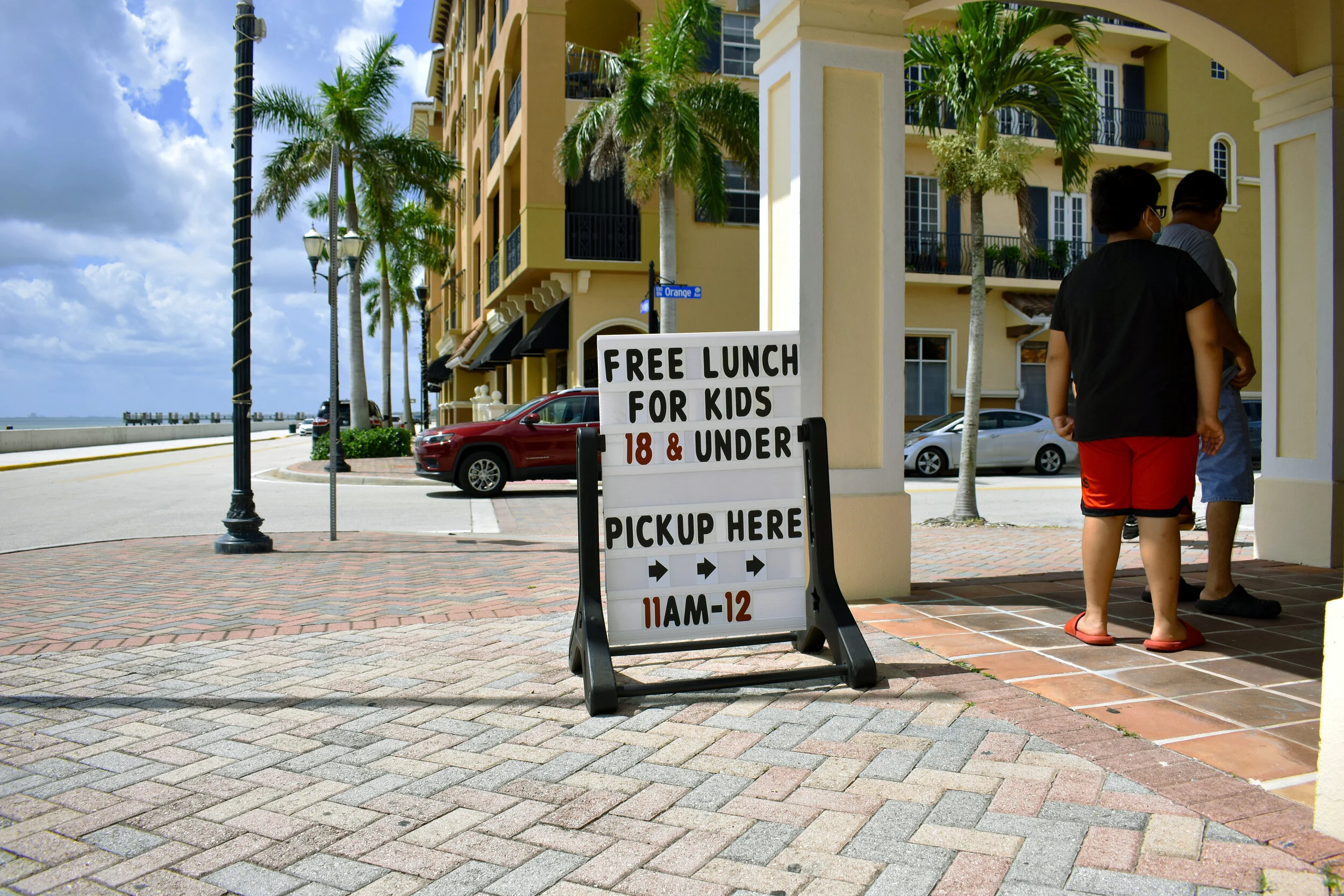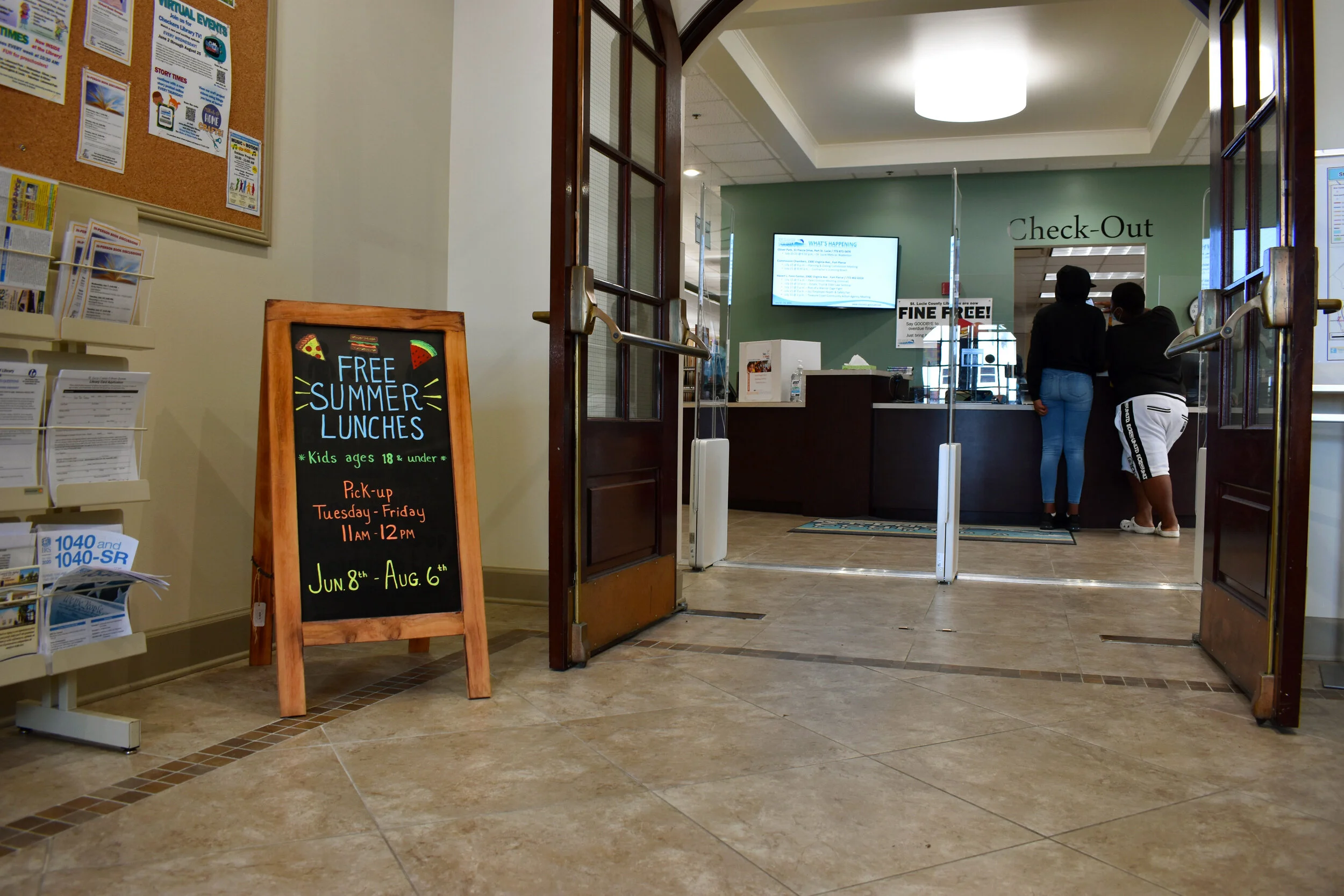809,480 Florida Children May Experience Hunger in 2021. Here is How the Pandemic is Worsening Food Insecurity on the Treasure Coast
Patrons approach a pickup station outside the Susan Broom Kilmer Branch Library in Fort Pierce, Fla., on July 21, 2021, to learn about the Summer Food Service Program. The federally funded USDA initiative provides free meals to children 18 and under during summer vacation. (Photo credit: Lindsey Leake)
Are Programs Keeping Little Bellies Full During COVID-19 Merely a Band-Aid?
FORT PIERCE, Fla. — By 11:45 a.m. most summer days, the Susan Broom Kilmer Branch Library is out of food, each grab-and-go meal having been discreetly gifted to a child or teen.
One late-July Wednesday, things were slow. Few followed the arrows on the sandwich-board sign out front, not even to seek respite from the 94-degree heat.
Adjacent to the lagoon-front library, a guitarist crooned “My Girl” at the Green Market, where artisans sold gemstones and coffee. Library staff waited at the threshold of a secondary entrance leading to a meeting room, in which paper-lantern jellyfish hung for “Under the Sea Storytime.”
“The library’s open,” a librarian called to a ponytailed patron with a girl of about six in tow. “We’re giving out free lunches for kids here until noon.”
The woman nodded curtly before disappearing into the lobby, giving the lunch station a wide berth. At one point, a man and two adolescent boys ambled hesitantly toward the table, where a flyer declared in English, Spanish, and Creole an official “Summer BreakSpot.” But for the bulk of the designated distribution hour, no swarms of families made a beeline for it, belying the magnitude of youth food insecurity on the Treasure Coast.
About one in five children in the region — Martin, St. Lucie, and Indian River counties — experience hunger, according to the Treasure Coast Food Bank. The COVID-19 pandemic threatens to heighten that divide.
“Especially in the very beginning, people were afraid,” said Judy Cruz, president and CEO of the Treasure Coast Food Bank. “Everybody needs to remember that feeling and understand that some people are still feeling that, and it’s through no fault of their own.”
Food Insecurity for Thought
Nationwide food insecurity was at a 20-year low before the pandemic, according to Feeding America, a partnership of 200 food banks that includes the Treasure Coast branch. Still, 35.2 million Americans — 10.7 million of whom are children — lacked reliable access to affordable, nutritious meals.
As many as 13 million children may experience hunger this year due to the repercussions of the coronavirus, the organization predicted. Florida’s population of food-insecure children is projected to rise to 809,480 — up from 722,300 in 2019 — keeping its third-place rank behind Texas and California.
Local children are not spared in the grim estimates. Feeding America anticipates the following 2019–20 child food insecurity rate increases:
• Indian River: 26 percent;
• St. Lucie: 28 percent;
• Martin: 29 percent.
As part of its quest to close the widening gap, the Treasure Coast Food Bank recently finished distributing meals during the season that Cruz said food-insecure families find most daunting: summer.
“A lot of the kids are afraid to not to be going to school, [where] they’re able to access free lunch and breakfast,” she said. “That’s a hard time for parents, typically, to provide those extra meals.”
That is where the Kilmer Branch Library comes in. It is a local partner in the national Summer Food Service Program (SFSP), a USDA-funded initiative administered by the Florida Department of Agriculture and Consumer Services. The library is one of thousands of Summer BreakSpots statewide, where children 18 and under may enjoy free meals when school is out.
In the six months beginning March 2020 — when the pandemic first shuttered Florida schools — more than 4,200 BreakSpots provided nearly 74 million meals, FDACS reported.
The Treasure Coast Food Bank has been involved for nearly a decade, Cruz said, preparing meals for distribution among the region’s BreakSpots. The nonprofit serves roughly 300,000 meals each summer.
“Children are our future, and they didn’t choose to live in the situation that they’re in,” Cruz said. “I feel like it’s our responsibility to take care of them, so people should look at what they could do to help support the kids.”
A Busy Mother’s Advice: “Reach Out” for Help
Darcel Craft-Ricketts is a self-proclaimed “crunchy mom.” She prioritizes her three kids’ nutrition, avoiding fast food and serving up produce grown in her garden. SFSP meals — which include breakfast, lunch, dinner and/or snack depending on location — have earned her seal of approval.
“It’s all about convenience for me and the fact that I can get these ready-made lunches,” said the 34-year-old children’s book author. “They’re healthy, they’re good. I feel good about them, my kids feel good about them.”
She is also the worship leader at the Port St. Lucie Worship Center International Ministries, the church where her children got grab-and-go meals this summer. It was the family’s first year utilizing the BreakSpot, she said.
“My husband and I … know our tax dollars are being put to good use, and we’re even able to tap back into this resource,” Craft-Ricketts said. “This is a great way to see where the money actually goes, knowing that it’s directly helping citizens in the community.”
Craft-Ricketts did not utilize the summer program daily but is grateful it was there when her family needed it. She said she promotes the SFSP to anyone who will listen, particularly in local parenting groups on Facebook, for an important reason: it can be scary to ask for help.
“Reach out,” she said. “It’s all about building community … not being afraid to connect.”
The Roots of Hunger
Just as the SFSP aims to curb youth hunger between academic terms, school-year programs bridge other fissures.
The Martin County School District is providing free breakfast and lunch for all students throughout the 2021–22 year, as well as offering dinner at select schools. The Treasure Coast Food Bank assists with after-school snacks and weekend meals.
Though admirable and effective, such initiatives equate to “a short-term answer,” said Whitney Fung Uy, data insights manager at Feeding Tampa Bay, another Feeding America bank. “We need to be thinking about, what are the root causes of food insecurity?”
A sandwich-board sign in the lobby of the Susan Broom Kilmer Branch Library in Fort Pierce, Fla., advertises the Summer Food Service Program as patrons visit the checkout desk on July 21, 2021. Children 18 and under receive free meals while school is out. (Photo credit: Lindsey Leake)
Outside of work, Fung Uy pursues doctoral research at the University of South Florida College of Public Health to uncover just that. The problem lies not in food shortage, she said, but in accessibility and affordability — corporate grocers driving the American food system instead of local farmers.
Locally, that disconnect is illustrated in a smattering of USDA-designated “food deserts,” low-income communities with limited food access. The Treasure Coast is home to more than 15 census tracts where the poverty rate is at least 20 percent and at least 33 percent of the population lives more than a mile from a supermarket.
It’s not an easy fix, Fung Uy said, but the first step is educating the public about where their food comes from.
“We want people to be self-sufficient,” Fung Uy said. “But we also have to think about the policies and the systems that are in place that don’t allow them to do that.”
In the meantime, Cruz and her colleagues at the Treasure Coast Food Bank are not only continuing their mission but also adapting to people’s needs during the pandemic — meeting them where they are, just as the nonprofit did in the summer.
“When push comes to shove, everybody works really well together,” Cruz said. “And the end result was that we filled a lot of bellies.”



